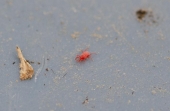
 6
6




 4
4




 2
2




INTRODUCTION
The purpose of this report is to summarize a study on using vitamin C to neutralize chlorine in water. The intended audience is sanitary engineers and operators of water and wastewater systems.
Operators of seasonal water systems sanitize spring-boxes or wells, storage tanks (figure 1), and distribution lines with a strong chlorine solution. After these operators sanitize the water systems, they must waste the chlorinated water. Chlorine can kill fish and other aquatic organisms. Therefore, operators must neutralize the chlorinated water before discharging the water into lakes or streams. The chlorinated water needs neutralizing if the wasted water goes to a septic system or small wastewater treatment plant, because chlorine can upset the bacterial balance in the system. Even very low levels of chlorine will harm or destroy aquatic organisms and beneficial bacteria. Operators need a permit from their State regulatory agency before discharging any treated or altered water to navigable waters of the United States or into a publicly owned wastewater treatment plant.
Water tanks in the field.
Figure 1 —Storage tanks.
CURRENT METHODS OF DECHLORINATION
Passive Methods
There are several passive methods for neutralizing chlorine. Operators may hold chlorinated water in a tank or pond until the chlorine dissipates because air and sunlight will neutralize chlorine over time. Operators may discharge the chlorinated water into soil, a road surface, or ditch, where the chlorine will react positively with organic and inorganic impurities. As long as the wasted water does not enter a lake or stream before the chlorine is neutralized, passive dechlorination (neutralization of chlorine) is preferable to chemical dechlorination.
Chemical Methods
Chemical methods of dechlorinating water are faster than passive methods. Water system operators may use sulfur compounds to dechlorinate water. However, to properly neutralize chlorinated water, operators need both caution and experience when using sulfur-based chemicals (Hill 2003). Sulfur-based chemicals are oxygen scavengers that will lower the dissolved oxygen in the receiving lake or stream, and some sulfur compounds are hazardous chemicals. At least two studies suggest that chlorinated and sulfonated water (sulfur-based dechlorination) poses a hazard to some sensitive aquatic species (Hall and others 1982; Rein and others 1992).
VITAMIN C DECHLORINATION
Vitamin C is a newer chemical method for neutralizing chlorine. Two forms of vitamin C, ascorbic acid and sodium ascorbate, will neutralize chlorine. Neither is considered a hazardous chemical. First, vitamin C does not lower the dissolved oxygen as much as sulfur-based chemicals do. Second, vitamin C is not toxic to aquatic life at the levels used for dechlorinating water. Although ascorbic acid is mildly acidic and, in large doses, will lower the pH of the treated water, sodium ascorbate is neutral and will not affect the pH of the treated water or the receiving stream. Both forms of vitamin C are stable, with a shelf life of at least 1 year in a dry form if kept in a cool, dark place. Once it is placed in solution, however, vitamin C degrades in a day or two.
Ascorbic Acid
One gram of ascorbic acid will neutralize 1 milligram per liter of chlorine per 100 gallons of water. The reaction is very fast. The chemical reaction (Tikkanen and others 2001) of ascorbic acid with chlorine is shown below:
C5H5O5CH2OH + HOCL → C5H3O5CH2OH + HCl + H2O
Ascorbic acid + Hypochlorous acid → Dehydroascorbic acid + Hydrochloric acid + water
Approximately 2.5 parts of ascorbic acid are required for neutralizing 1 part chlorine. Since ascorbic acid is weakly acidic, the pH of the treated water may decrease slightly in low alkaline waters.
Sodium Ascorbate
Sodium ascorbate will also neutralize chlorine. It is pH neutral and will not change the pH of the treated water. Sodium ascorbate is preferable for neutralizing high concentrations of chlorine. If a large amount of treated water is going to be discharged to a small stream, the pH of the treated water and the stream should be within 0.2 to 0.5 units of the receiving stream.
The reaction (Tikkanen and others 2001) of sodium ascorbate with chlorine is shown below:
C5H5O5CH2ONa + HOCL → C5H3O5CH2OH + NaCl + H2O
Sodium ascorbate + Hypochlorous acid → Dehydroascorbic acid + Sodium chloride + water
Approximately 2.8 parts of sodium ascorbate are required to neutralize 1 part chlorine. When vitamin C is oxidized, a weak acid called dehydroascorbic acid forms.
Several studies have evaluated the use of ascorbic acid and sodium ascorbate to neutralize low levels of chlorine—less than 2 milligrams per liter. Only one study (Tacoma Water Utility Report) evaluated the use of ascorbic acid to neutralize high levels of chlorine—up to 100 milligrams per liter. The Tacoma, WA, Water Utility Engineer recommends against using ascorbic acid to neutralize high levels of chlorine in large volumes of water because it lowers the pH of the treated water. The Tacoma Water Utility engineer recommends using sodium ascorbate instead.
The San Dimas Technology and Development Center project leader set up a small experiment to evaluate water changes during the use of sodium ascorbate or ascorbic acid to neutralize a strong chlorine solution (figure 2). The experiment consisted of:
• Making a strong chlorine solution (approximately 50 milligrams per liter chlorine).
• Neutralizing the chlorine solution with either ascorbic acid or sodium ascorbate.
• Monitoring pH, temperature, dissolved oxygen, total chlorine, and free chlorine after each step
 3
3




 5
5





 1
1





|
Forget this weirdo. You guys wanna see something really neat? I just have to take off my shoe .... (hint: it's a tiny ad)
Learn Permaculture through a little hard work
https://wheaton-labs.com/bootcamp
|




